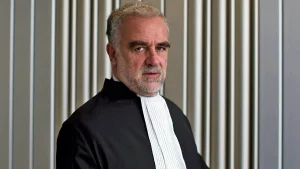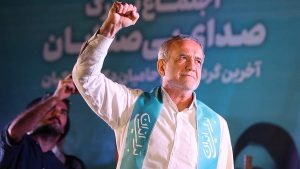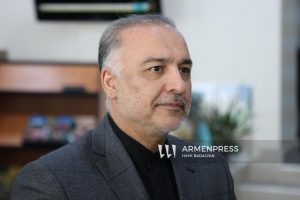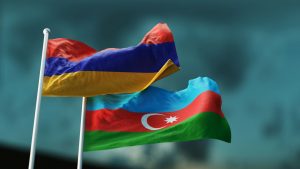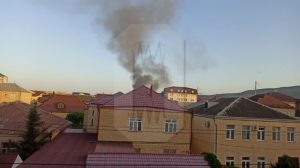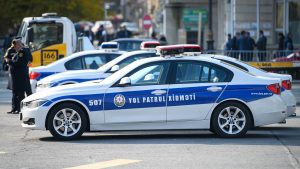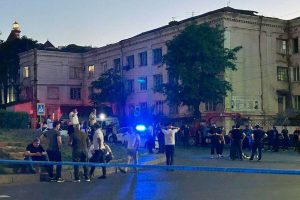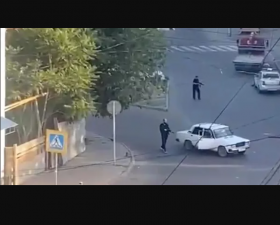Published by Conflict Intelligence Team
Almost from the very beginning of the aggravation of the conflict in Nagorno-Karabakh, reports began to come in about the participation of “Syrian mercenaries” in battles on the side of Azerbaijan. The Azerbaijani side officially denies the presence of mercenaries in the conflict zone: for example, this information was rejected by Azerbaijani President Ilham Aliyev in an interview with France 24 , as well as Turkish President Recep Erdogan in his speech in parliament. However, not only pro-Armenian accounts wrote about this, but also independent experts on the Syrian conflict, and journalists of many major Western media interviewing sources in Syria, and even the authorities of many countries, including the President of France personally, have officially announced this.
In addition, during the conflict, several videos have appeared on the network, often posted by the alleged mercenaries themselves. Arabic speech is heard in the video, although the fighters themselves are dressed in the uniform of the State Border Service of Azerbaijan without insignia and body armor in a different camouflage used by the country’s Ground Forces.
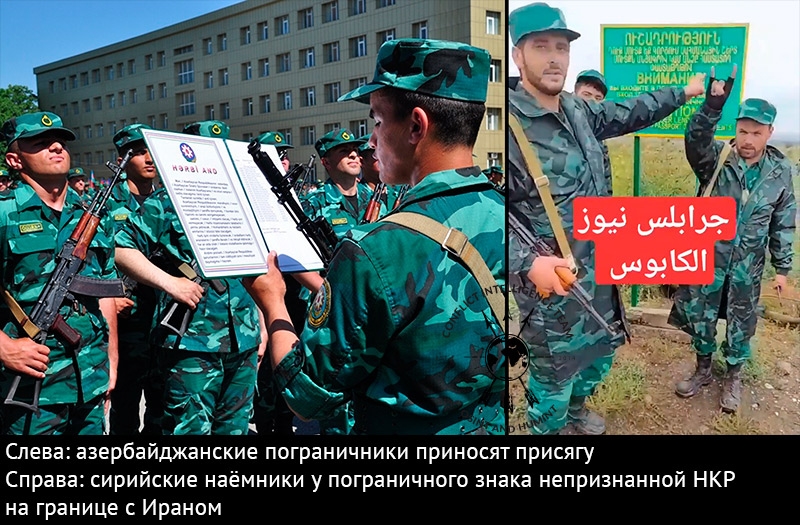 Social media users managed to geolocate these videos, confirming that they were actually filmed both in the territory controlled by the Azerbaijani authorities and in the territory of the self-proclaimed Nagorno-Karabakh Republic, which were occupied by Azerbaijani forces. In particular, the Syrians are present in the southern part of the front line, where heavy fighting for the settlement of Hadrut has taken place in recent days.
Social media users managed to geolocate these videos, confirming that they were actually filmed both in the territory controlled by the Azerbaijani authorities and in the territory of the self-proclaimed Nagorno-Karabakh Republic, which were occupied by Azerbaijani forces. In particular, the Syrians are present in the southern part of the front line, where heavy fighting for the settlement of Hadrut has taken place in recent days.
Thus, data from open sources refute the statements of the authorities of Azerbaijan and Turkey that the Syrian mercenaries are not involved in the conflict. At the same time, during the conflict, information appeared in the media that makes it possible to understand more about the composition and training of mercenaries, as well as about the chronology and purposes of their introduction into the zone of the Azerbaijani-Armenian conflict.
The Syrians who are fighting in Nagorno-Karabakh are fully or almost entirely recruited in northwestern Syria. In addition to local residents, there are many refugees (more precisely, internally displaced persons) from the areas of the country controlled by Damascus. These territories are fully or partially controlled by Turkish troops, which have been expanding their presence in Syria since 2016, including with the help of groups recruited from the Syrians.
Turkish troops managed to protect part of Syria from the dictatorial regime of Assad, but this part of the country did not escape an all-Syrian economic collapse and general unemployment caused by the war and the recent double devaluation of the national currency. Conflict researcher Elizaveta Tsurkova says that over the nine years of the conflict, a generation of young Syrians has grown up who have practically no skills other than combat skills, and even have difficulty reading and writing. At the same time, according to The Guardian, ordinary fighters of the pro-Turkish groups receive 450-550 Turkish liras (around $ 70) a month, which is barely enough to live on. All this creates the basis for recruiting mercenaries who are ready to defend Turkish interests in Libya, and now in Azerbaijan for money.
Back in July, when the previous exacerbation of the Azerbaijani-Armenian conflict began (recall also that joint Turkish-Azerbaijani military exercises were held in late July – early August ), The Independent became aware of plans to involve the Syrians in the Transcaucasian conflict. According to Tsurkova, in early August, intermediaries began to appear in Afrin, later starting to recruit fighters. The Guardian’s interlocutors named September 13 and 18 as the dates when they signed contracts, and the WSJ writes that the transfer of fighters has already begun in the middle of the same month. Finally, on September 23 – four days before the start of the war – a little-known anonymous resource SyriacPress reportedon the dispatch of members of one of the pro-Turkish groups to Azerbaijan, giving details that coincided with the articles published in the Western press after the start of the war. Based on the combination of these and other signs, we can confidently conclude that the current military actions were prepared by the Azerbaijani-Turkish side in advance, and are not the result of another accidental aggravation.
The newspaper Kommersant reports , referring to Russian military-diplomatic sources, that the recruitment was carried out, among other things, by the SADAT PMC, connected with the Turkish authorities, The Independent’s source is less specific, mentioning a certain Turkish private security firm (private Turkish security firm).
The interlocutors of different media indicate similar numbers, speaking about the payment of mercenaries. So, “Kommersant” writes that the Syrians were promised up to $ 1,500 of “lifting” and more than $ 2,000 a month, the BBC’s Arab service – $ 2,000, SyriacPress – $ 1,800, Reuters calls the amount of $ 1,500 a month, as well as CNN , The Independent and The Guardian – from $ 1000 (7000 lira) and above, Tsurkova mentions the range from $ 600 to $ 2500, and the newspaper L’Express– $ 1000. We think that the discrepancy can be explained by two reasons: firstly, the salary must certainly depend on the military specialty or position, and secondly, according to The Guardian, some Syrian rebel commanders pocket up to 20% of the salaries of their subordinates. In addition, the families of mercenaries promised in the event of the death of 60,000 lire (7,800 dollars) while maintaining the names of those killed in secret, told them the magazine Foreign Policy.
Any of these amounts is very big money by the standards of the beggarly earnings of peaceful Syrians and fighters of pro-Turkish groups. However, the mercenaries are driven not only by mercenary interests or the desire to feed their families – for example, one of the fighters told AFP that he and his comrades are grateful to Turkey for protecting against Russia in Syria and are ready to speak out for its interests.
According to Kommersant’s sources, documents and personal communications were taken away from the mercenaries, and The Times also writes about the difficulty of communicating with the mercenaries due to the fact that they were deprived of their phones. Finally, the BBC’s Arab service clarifies that during the training of Syrians in Turkey, not only their phones, but also their clothes and cash were confiscated so that their nationality could not be identified. All this did not help completely prevent the leakage of video materials revealing the transfer, which now the Turkish-Azerbaijani side is forced to call fakes. Nevertheless, after October 11, we did not come across new videos from the Syrians – perhaps, threats to jail the publisher of one of the videos worked, about which it wrote on October 12 Jordan-based Syria Direct.
Estimates of the estimated number of Syrians vary: for example, the source told Reuters about the transfer of 1,000 fighters, Kommersant talks about 1,300 in the first week alone, and Foreign Policy claims that their number reaches 1,500. At the same time, Armenian Ambassador to Moscow Vardan Toganyan said RIA Novosti on the transfer of 4,000 Syrian fighters, but this figure is clearly overstated.
Many combatants report that in recruiting, which, as described above, took place before the start of the war, they were misled about the purpose of the “mission”. For example, Syria Direct writes from the words of the mercenaries that they were hired to guard some (possibly military) Turkish installations (Turkish bases, Turkish installations) in Azerbaijan, The Guardian’s sources mention the protection of observation posts and oil and gas infrastructure (observation posts and oil and gas facilities), and the interlocutors of the BBC, SyriacPress and Foreign Policy say that they went to guard military posts on the border or the contact line (manning guard posts along border demarcation lines) – here it is worth remembering that in the video the Syrians are dressed in the uniform of Azerbaijani border guards.
Arriving under the pretext of protecting the Syrians were thrown into battle almost immediately after the start of the war, and the mercenaries began to suffer quite heavy losses: on October 5, Foreign Policy reported 55 killed, Tsurkova clarifies that so many bodies were transferred on the Turkish-Syrian border on the night of October 4. We could not find newer accurate data (although the researcher wrote about the planned transfer of about fifty more bodies on October 12), but we assume that given the severity of the fighting in the south, the number should have increased since then.
Many of the mercenaries told the media about their desire to return home: according to WSJ sources, the number of such applicants reaches at least 200. Friends and relatives of the fighters told The Independent that after reports of mass casualties, they launched a public campaign in Syria, calling on young people do not go to fight in Azerbaijan.
It is curious that an acquaintance of the interlocutor of Syria Direct complained to him that he had come to the country as a border guard, and not as a military man, and expressed his unwillingness to continue to fight with the Shiite Azerbaijanis at the same time that the Shiite Assad regime was exterminating the Sunni population in Syria. Other Syrians told The Independent and The Times that they changed their minds at the last minute for the same reason.
Nevertheless, the Syrian fighters can hardly be called religious fanatics, as the Armenian side does. So, the interlocutors of Tsurkova, who served in Libya before Azerbaijan, massively consumed alcohol and even drugs. The Daily Beast accused one of the commanders of the pro-Turkish group “Hamza Brigade” of being in the “Islamic State”, but as the researcher of the Syrian conflict Aymen at-Tamimi explains , we are talking at most about a joint operation of the Syrian rebels and the “IS” (then the Islamic State of Iraq and the Levant) against Kurdish militias in northeastern Syria in 2013. Subsequently, ISIS cleared out the provinces of Deir ez-Zor and Raqqa from their former situational allies.
It should be noted that in response to the testimony of Syrian mercenaries, pro-Turkish and pro-Azerbaijani users of social networks began to claim that militants from Iraq, including those from the Kurdistan Workers’ Party (recognized in Turkey and in many countries of the world as a terrorist organization), were allegedly fighting on the side of Armenia. However, there is virtually no evidence of this. Most often, supporters of this theory cite a photograph of fighters in camouflage uniforms with the flag of Armenia and other flags with symbols, which are often used by the ethno-religious community of Yezidis, including those living in Iraq. This photo was posted by Rustam Bakoyan, a member of the Armenian parliament from the ruling My Step party, who calls himself a representative of the Armenian Yezidis (of whom, according to official figures, there are about 40 thousand in the country). Before that, shortly after the start of the clashes, Bakoyan announced the formation of a militia detachment from representatives of the Yezidi community of Armenia to participate in hostilities.
The presence of Syrians in the conflict zone is just one aspect of the Turkish authorities’ assistance to Azerbaijan. Thus, the Bayraktar TB2 Turkish attack drones, which were previously used in Syria and Libya, are successfully operating against Armenian equipment and manpower. They were officially handed over to Azerbaijan in July, but there is little doubt that they are operated by Turkish operators, and not Azerbaijani, which could hardly have been trained in such a short time. In addition, the New York Times investigation revealed the presence of supposedly Turkish F-16s on the territory of Azerbaijan – earlier the Armenian military claimed that one of them shot down a Su-25 attack aircraft of the Armenian Air Force. After the investigation, Aliyev was forced to admit the presence of F-16s in Azerbaijan, but he assured that they were not used in the Karabakh conflict.




